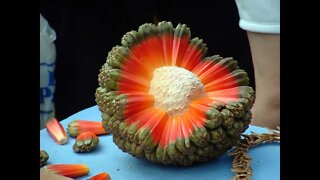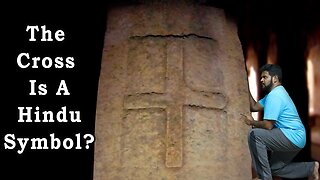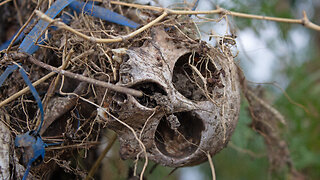THE SPIRITUAL REASONS FOR USING COCONUTS IN HINDU POOJAS?
A coconut, which is symbolized by the act of shattering the fruit on the ground, is almost always present during a Hindu rite. Coconuts are essential to the performance of Puja rites since their inclusion is said to bring good fortune. Coconut is significant for a lot of reasons, and those reasons are all listed below.
The word for "coconut" in Sanskrit is "Sriphala," which translates to "the sign of the almighty." Weddings, new constructions, festivals, and homas are just some of the numerous occasions when coconuts make an appearance. Good or bad, it doesn't really matter. As a result of the fruit's positive connotations, it may be found at almost every Hindu temple, where worshipers can present it as an offering to the deity.
If you look carefully, the coconut has a lot of similarities to the shape of the human head. The coir, which represents human hair, contrasts with the interior, which is the hard nut and depicts the human skull. The water that is contained inside the coconut is said to represent the blood, and the white kernel is thought to represent the metal area that is contained within the skull. Despite the fact that the idea is bizarre and unsettling, the fruit has undoubtedly served as a rescuer for human existence and plays a significant role in religious and spiritual practice.
The coconut palm, also known as Kalpavriksha, is revered in Hinduism as a tree that bestows everything that it has onto others. While the leaves of the tree are used for thatching roofs and constructing enclosures, the edible portion of the coconut known as the kernel is beneficial to one's overall health and should be consumed whenever possible.
Even for serious health problems, the water found inside of a coconut is very clean and free of impurities; as a result, it is a good source of rehydration. There are several advantages of drinking coconut water. The water is an excellent way to relieve your thirst and may also be used to treat burns, rashes, and bruises. Coconuts may be carved into various objects, used as decorations, made into soaps, and even utilized to extract important coconut oil.
Did you know that the three circular circles that are seen on the coconut are said to represent the eyes of Lord Shiva? Because of this, coconut is regarded to be crucial for every ritual, and before beginning a Pooja, it is placed in a saucepan with rice and mango leaves to keep it warm. It is stated that whoever breaks the coconut will have their desires granted if they do it at the right time.
There are three gods who are always present wherever there are coconuts, and their names are Brahma, Vishnu, and Shiva. It is believed that the three lords would visit the household and bless them if a coconut is maintained in the pooja while it is being performed. There are several instances in which certain coconuts are not broken or offered as Prasad in order to ensure that all three deities are present in the home until the coconut is finally smashed.
Every devotee receives a piece of coconut as part of the Prasad they receive at temples. It is a symbol of cleanliness, and the fact that Prasad is distributed to everyone lends credence to the idea that receiving it cleans a person's heart, mind, and spirit. Because of this, everything begins and finishes with coconut so that both purity and drishti might be attained.
As a result, we are aware of the significance of coconut and how it plays a significant role in the process of cleaning human health and spirit, and the value of this topic cannot be overstated. Customs and traditions have long been a fundamental part of Hinduism, and adherents are often reminded that honoring these tenets is just as essential as praying to a higher power.
You have undoubtedly improved your understanding of this topic as a result of being more knowledgeable about the significance of coconut. Please let us know if you found it to be helpful. Leave a comment and tell us what you think.
Read Our Blog: https://ramabaktha.site/why-are-coconuts-used-in-hindu-poojas/
-
 3:47
3:47
Thinglish Lifestyle
1 year agoEmotional and Spiritual Benefits of Ceremonial Cacao
121 -
 0:55
0:55
RT
10 months agoCoconut-smashing ritual honours deity at Aadi Perukku Hindu festival
5.21K17 -
 5:24
5:24
Natural Cures
7 years ago $0.14 earnedThe Surprising Benefits and Uses of Coconut Oil
466 -
 8:44
8:44
asolitarypagan.com
1 year agoMagical Practices in the Herbal Way
165 -
 4:58
4:58
Earth Titan
8 years agoTop 10 Tropical Fruits You've Never Heard Of
128 -
 0:09
0:09
Mbkitchenette
1 year agoCoconut hack: A Viral Century-Old Secret Revealed!: Coconut Flesh Removal Technique
13 -
 9:32
9:32
Praveen Mohan - Hindu Temples
1 year agoDid Ancient Hindus Worship The Cross ? Was The Cross Carved in Indian Temples?
2361 -
 1:09
1:09
WildCreatures
4 years ago $0.11 earnedTourist shares bananas with one armed wild monkey in India
3.47K3 -
 11:01
11:01
NehaKulkarni
1 year agoSikhism: The ritual of (Guru) foot water drinking (Charan Amrit)
83 -
 4:40
4:40
ToDelawareAndBeyond
1 year agoMonkey skulls tied to a tree in Nagaland, Northeast India
13